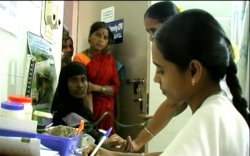 Cervical
cancer kills more Indian women than any other disease. Three-quarters
of the world's burden of cervical cancer falls on developing countries
such as India. Cervical
cancer kills more Indian women than any other disease. Three-quarters
of the world's burden of cervical cancer falls on developing countries
such as India.
Late presentation
of women with cervical cancer is predominantly due to both inadequate
knowledge and lack of effective screening, especially in rural areas.
A search for alternative
low-technology screening methods for women in remote, rural regions
was instigated in the 1990's. The
Institute for Rural Health Studies (IRHS) took part in this process
by validating visual inspection of the cervix for cancer using trained
village-level health workers.
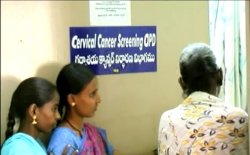 A
full description of this study can be seen here as a WORD
document or a PDF
document. A
full description of this study can be seen here as a WORD
document or a PDF
document.
|
 |
 Swathi
is one of our Community Health Workers, trained by us. She is examining
a patient specimen and will write a lab report for our fully-trained
paramedics. Swathi
is one of our Community Health Workers, trained by us. She is examining
a patient specimen and will write a lab report for our fully-trained
paramedics.
This will enable
them to treat the patient correctly.
More than 90 percent
of patients don't need to be referred to the district hospital or to
Hyderabad, the capital city . We have the resources and skills to treat
them in the village clinics.
|
 |
|
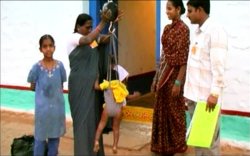 Jayamma
is a community health worker; she makes regular visits to households with
children and pregnant women. We monitor the growth of all children from
birth to 3 years. We also provide an appropriate food supplement to those
at risk. Jayamma
is a community health worker; she makes regular visits to households with
children and pregnant women. We monitor the growth of all children from
birth to 3 years. We also provide an appropriate food supplement to those
at risk.
42% of children in
India are malnourished. Most of that is borne by rural villagers who have
little understanding and even less ability to do anything about it, resulting
in stunted growth and susceptibility to illness. Recently, the Prime Minister
called it a 'national shame'.
|
 |
|
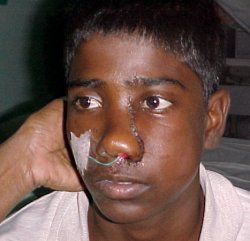 Raghavendra
- a fatherless boy - had a rare debilitating and disfiguring tumour which
threated to grow upwards into his brain. Raghavendra
- a fatherless boy - had a rare debilitating and disfiguring tumour which
threated to grow upwards into his brain.
A team of doctors
representing several specialties tackled his tumour in a corporate hospital
which waived the fees for his surgery.
Often, IRHS is able
to convince corporate hospitals to look after such complex cases. We have
excellent relationships with Hyderabad's many specialist hospitals and
their staff.
|
 |
|
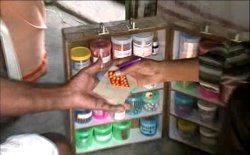 Both
of our clinics have fully-furnished pharmacies carrying nearly 100 essential
generic drugs of high quality. On the right is our small travelling pharmacy
that can be carried to a home or a mobile clinic. Both
of our clinics have fully-furnished pharmacies carrying nearly 100 essential
generic drugs of high quality. On the right is our small travelling pharmacy
that can be carried to a home or a mobile clinic.
It is modelled after
the old chemistry set used by children in the West.
|
|
|
|
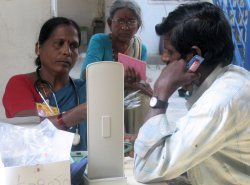 Jayamma
is taking a patient's blood pressure in the reception area of the Dokur
clinic. Jayamma
is taking a patient's blood pressure in the reception area of the Dokur
clinic.
Every
adult patient is monitored for hypertension as this is a major health
problem in India. We have a separate hypertension register.
Those
diagnosed as hypertensive are routinely treated using appropriate medication.
Lifestyle management is also part of the treatment.
|
 |
|
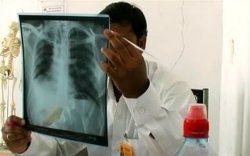 Shivaiah,
our Senior Paramedic, is examining an x-ray at the Dokur clinic. Shivaiah,
our Senior Paramedic, is examining an x-ray at the Dokur clinic.
The x-ray originally
came from a private doctor in Mahbubnagar town, but the patient doesn't
know what it tells him and the doctor didn't explain.
He has brought it
to us for an explanation and treatment.
|
 |
|
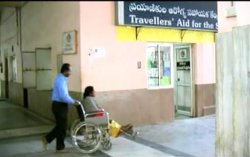 This
is our very successful 'Traveller's Aid for the Sick' facility at Hyderabad's
huge bus station. This woman fell off a bus and has a severe head injury.
We found her when our counsellor took his regular turn scouring the platforms
for injured or sick passengers. This
is our very successful 'Traveller's Aid for the Sick' facility at Hyderabad's
huge bus station. This woman fell off a bus and has a severe head injury.
We found her when our counsellor took his regular turn scouring the platforms
for injured or sick passengers.
Each year since 1997,
we have helped between 4000 to 5000 travellers - treating them with first
aid or getting them to an appropriate hospital. Villagers, unused to city
bustle, can often fall prey to unscrupulous touts and misdirected to fake
treatments. Many other preventive efforts take place in the centre.
|
 |
|
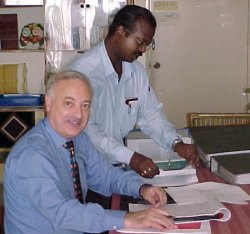 IRHS
has frequently engaged in collaborative research with other organisations
or carried out independent research in rural areas. IRHS
has frequently engaged in collaborative research with other organisations
or carried out independent research in rural areas.
Our research has been
funded by such diverse organisations as the Ford Foundation and the United
Nations University.
Here an auditor from
Unilever Research in the UK is examining results from a study carried
out in several villages in the district.
|
 |
|
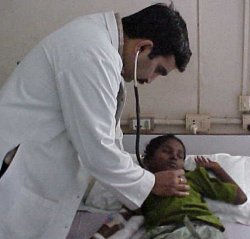 Dr
Nitin Rao is a Pediatric Cardiologist. He is examining young Nandini,
who suffered from Cardiomegaly (enlarged heart). Dr
Nitin Rao is a Pediatric Cardiologist. He is examining young Nandini,
who suffered from Cardiomegaly (enlarged heart).
This serious condition
ultimately resulted in Nandini's death at the age of eleven.
Nandini was actually
one of the more fortunate as she had medical care to ease her suffering
- many children in rural areas die without ever seeing a doctor.
|
 |
|
 Shobha
is a tribal girl, totally deaf and motherless. Her illiterate father was
told about IRHS while a migrant labourer in Mumbai and returned to Hyderabad
to see if we would help his daughter. Shobha
is a tribal girl, totally deaf and motherless. Her illiterate father was
told about IRHS while a migrant labourer in Mumbai and returned to Hyderabad
to see if we would help his daughter.
IRHS used the services
of the AYJ National Institute for the Hearing Handicapped to obtain care
and a hearing aid for Shobha.
|
 |
|
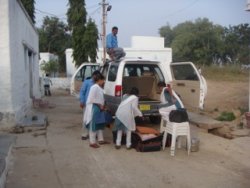 Each
Tuesday, clinic staff load clinic equipment in and on top of the van to
travel to Kotakadra village in Palamoor Mandal. Each
Tuesday, clinic staff load clinic equipment in and on top of the van to
travel to Kotakadra village in Palamoor Mandal.
This clinic is run
from a two-room house (lab and pharmacy) while patients are seen inside
a temple compound.
After clinic is finished,
the staff have lunch in the temple and follow it with a teaching session
led by staff or volunteer doctors.
|
 |
|
 Life
in these impoverished villages isn't all desperation and disease. Here,
the women of Dokur village celebrate their Bonalu festival for the goddess
Durga. Life
in these impoverished villages isn't all desperation and disease. Here,
the women of Dokur village celebrate their Bonalu festival for the goddess
Durga.
The pots are filled
with a mixture of cooked rice, vegetables and chicken and then offered
to the goddess in her temple. Afterwards, everyone gathers to enjoy the
meal.
Toddy is generally
consumed in good quantities and a good time is had by all.
|
 |
|
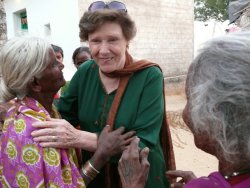 Dr
Pat has worked for more than thirty years in these Mahbubnagar villages
and is well-known and much-loved. Dr
Pat has worked for more than thirty years in these Mahbubnagar villages
and is well-known and much-loved.
Apart
from her efforts for early detection of cervical cancer, she also has
a special interest in the welfare of widows, who in this patriarchal society
are often at a grave disadvantage in their twilight years if their children
have moved to urban centres for work.
She
is now actively seeking funds to establish a home for those widows who
have been abandoned. An effort is being made to contruct an ecological
environment using solar energy, water harvesting and a sustainable crèche
for income generation.
|
 |
| From
time to time, we conduct 'Health Camps' in the tribal villages of Vizag
District. This means we take an 8-hour train trip followed by a six-hour
jeep ride and then we walk for two hours into the mountains, carrying our
kit and medical supplies. |
|
|
|
Dr Pat and
a paramedic hold a medical camp in a remote tribal village.
With no consultation
room, a locally provided bed becomes an examination table.
The villagers
crowd around waiting for their turn.
|
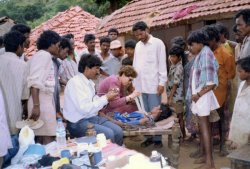
|
 |
|
A volunteer,
Dr Ruth Torlesse, examines a Konda Dora man with a severe leg infection.
She is assisted by IRHS staff, Nathan.
Antibiotics
are provided and dressings left behind after teaching his wife how to
dress his wounds.
|
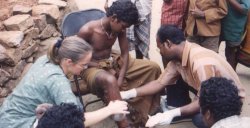
|
 |
|
Goitre is
common in the mountainous tribal areas due to iodine deficiency in India's
mountainous regions and these two Konda Dora ladies are extreme examples.
They were
ultimately referred to King George Hospital in Vizag.
|
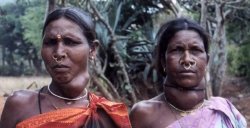
|
 |
|
This man
has come to us because local treatment has failed and he is still ill.
Many tribals
believe that one can rid oneself of illnesses by burning the body, and
his abdomen has been burned with cigarettes to cure him of his fever
|
.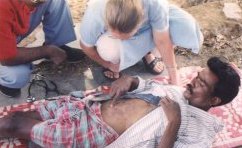
|
 |
|
This is a
closeup of the previous patient showing his extensive and disfiguring
burns.
He was subsequently
treated for his malaria and made a full recovery.
|
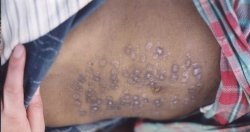
|
 |
|
Small
areas of the hills can support paddy (rice) cultivation.
These women
are scooping up irrigation water for bathing purposes after working in
the fields.
|
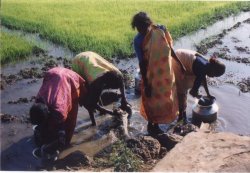
|
 |
|
Cleft lip
and palate are common among rural people due to consanguinous marriages.
This Valmiki boy is a severe example.
He was referred
to King George Hospital where surgery was done at no charge, although
he and his father had to travel 6 hours after a two-hour descent by foot
from the mountain.
|
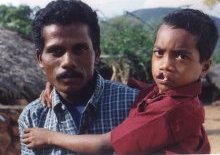
|
 |





















